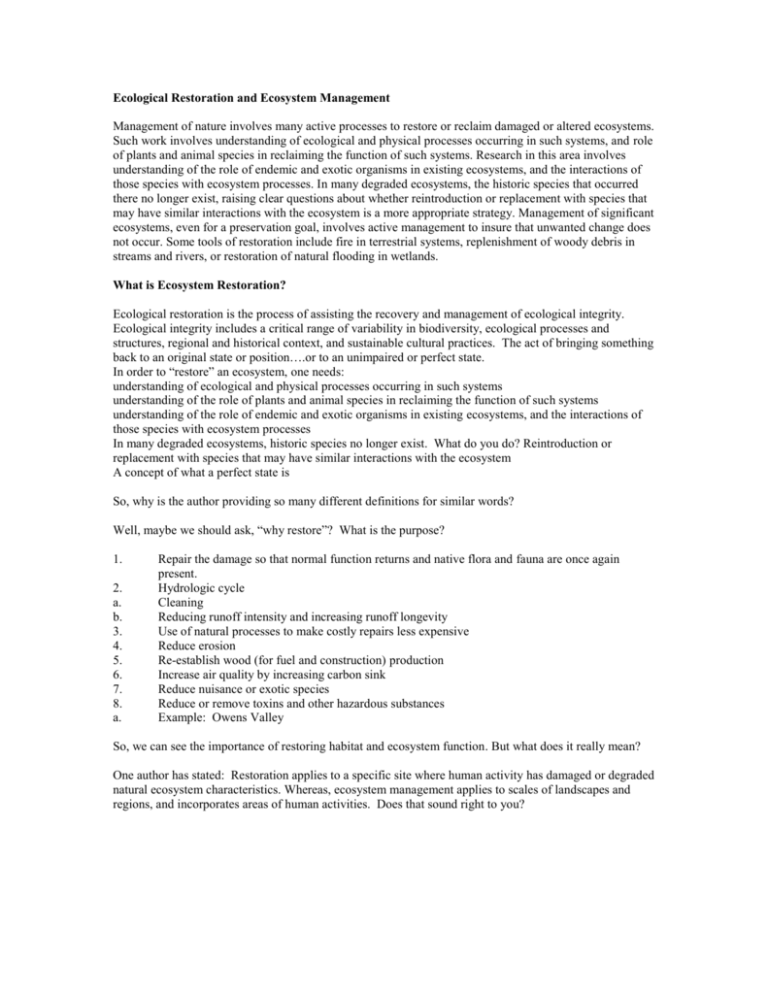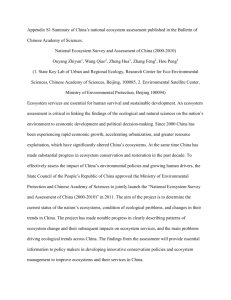What is Ecological Restoration
advertisement

Ecological Restoration and Ecosystem Management Management of nature involves many active processes to restore or reclaim damaged or altered ecosystems. Such work involves understanding of ecological and physical processes occurring in such systems, and role of plants and animal species in reclaiming the function of such systems. Research in this area involves understanding of the role of endemic and exotic organisms in existing ecosystems, and the interactions of those species with ecosystem processes. In many degraded ecosystems, the historic species that occurred there no longer exist, raising clear questions about whether reintroduction or replacement with species that may have similar interactions with the ecosystem is a more appropriate strategy. Management of significant ecosystems, even for a preservation goal, involves active management to insure that unwanted change does not occur. Some tools of restoration include fire in terrestrial systems, replenishment of woody debris in streams and rivers, or restoration of natural flooding in wetlands. What is Ecosystem Restoration? Ecological restoration is the process of assisting the recovery and management of ecological integrity. Ecological integrity includes a critical range of variability in biodiversity, ecological processes and structures, regional and historical context, and sustainable cultural practices. The act of bringing something back to an original state or position….or to an unimpaired or perfect state. In order to “restore” an ecosystem, one needs: understanding of ecological and physical processes occurring in such systems understanding of the role of plants and animal species in reclaiming the function of such systems understanding of the role of endemic and exotic organisms in existing ecosystems, and the interactions of those species with ecosystem processes In many degraded ecosystems, historic species no longer exist. What do you do? Reintroduction or replacement with species that may have similar interactions with the ecosystem A concept of what a perfect state is So, why is the author providing so many different definitions for similar words? Well, maybe we should ask, “why restore”? What is the purpose? 1. 2. a. b. 3. 4. 5. 6. 7. 8. a. Repair the damage so that normal function returns and native flora and fauna are once again present. Hydrologic cycle Cleaning Reducing runoff intensity and increasing runoff longevity Use of natural processes to make costly repairs less expensive Reduce erosion Re-establish wood (for fuel and construction) production Increase air quality by increasing carbon sink Reduce nuisance or exotic species Reduce or remove toxins and other hazardous substances Example: Owens Valley So, we can see the importance of restoring habitat and ecosystem function. But what does it really mean? One author has stated: Restoration applies to a specific site where human activity has damaged or degraded natural ecosystem characteristics. Whereas, ecosystem management applies to scales of landscapes and regions, and incorporates areas of human activities. Does that sound right to you? Diagrams: Ecosystem function (biomass and nutrient content) Replacement or reclamation Original Ecosystem Rehabilitation Mitigation = Natural processes Rehabilitation of another ecosystem Degradation Degraded Ecosystem Restoration *Most prized outcome Most costly Time consuming Very complex Ecosystem structure (species & complexity)








